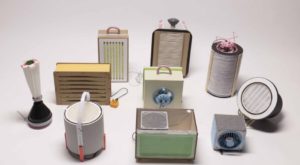Helen Hamlyn (2019) design innovation awards
What are these objects? How can we use them? Are they modern or vintage?
Answers on a postcard please…
#HH@theRCA
Helen Hamlyn (HH)Trust has been breaking new boundaries in inclusive design since 1991 and became fully founded in 1999. The Helen Hamlyn centre is the largest centre for design in the Royal College -London and recognised by inclusive designers across the world for its cutting-edge common-sense approach to product design.
Who is Helen Hamlyn; I hear you ask?
Lady Helen Hamlyn, graduated from the Royal College of Art in the middle of the 1950’s, and worked for Debenhams. However, her philanthropic work – examining design for the aging, in the mid-eighties, became her most important signature work. Helen is quoted as saying “First you see the problem, then you find the answer, then you design something…”(2016). In 1999 Helen and her famous philanthropist husband Paul Hamlyn launched the Helen Hamlyn trust Design centre at the RCA which since has become one of their most famous sections of their charity work in the PHT portfolio.
Today, the Helen Hamlyn trust has become a global centre famed as an inclusive centre which sets participant/user at the centre of design thinking. The impact of the Helen Hamlyn Trust is shown through international conferences and 24/48hr design challenges, workshops, design tools and commercial design concepts/products. Working with academic communities such as Cambridge university http://designingwithpeople.rca.ac.uk/ the trust has produced key tools for designers to use when working with people with ability needs. The work pack promotes how to work with others, how to observe issues using well-known design techniques (a day in the life) and offering how-to guides using innovative process such as gaming methodologies to gauge a deeper understanding of user needs.
Using one to one, deep-dive interviews, design capsules, think-aloud techniques and observations Helen Hamlyn website offers links and resources available for designers to download and use at will. One of the most used resources are the RAQ’s and user-fact sheet (Helen Hamlyn- www.rca.ac.uk). Set around simple terms the Helen Hamlyn process is as simple to understand using themed terms e.g. asking –promotes more designers to ask the right questions to gain a better understanding of user needs. Asking is also linked to descriptors for recording and understanding and enabling transcriptions to gain vital user-led detail. Co-creating – HH promotes working with users as co-designers, participants are considered equals in the Helen Hamlyn design process. Futuring -this theme embraces the new, the future thinking the fictional and almost non-believable concepts which capture a user’s and designers imagination to make the design concepts leap off the drawing board. Other themes include immersing and listening -offering new ways to immerse ones self in the role of user and new ways to simply put down tools and listen to users needs and their own claims about their own condition.
Example of ‘Prototyping’ methodology Helen Hamlyn 2015
What has Helen Hamlyn ever done for designers?
Using the wealth of Helen Hamlyn tools, inclusive of probes, capsules and well worked techniques is still not offering a magic alchemic solution to all the worlds needs. However, what it does provide to designers and ‘design thinkers’, is a way to capture a ‘whole person’ needs, thoughts and wishes in the design process. As designers we always believe we are offering due process and accessing user needs, but do we? The Helen Hamlyn approach allows designers to reflect and be reflexive in our work, in our thoughts and effecting greater impact. Using the techniques and methods we can ask new questions on where we are placing the users in the cycle ‘am I placing the user at the centre of design cycle or at the end?’ Using HH techniques, we as designers can take on new roles as part of the design cycle, e.g. facilitators and enablers.
Designers associated with Helen Hamlyn show us that many of the most creative concept generations don’t have to be finished and polished pieces, but the designed products must work and work well.
Returning to the selection of objects at the start of this blog, have you guessed yet? If you would like to peak, then the objects are all part of a Helen Hamlyn excellence awards (2019) follow the links https://www.rca.ac.uk/news-and-events/news/excellence-inclusive-design-recognised-royal-college-art-helen-hamlyn-design-awards/



Leave a Reply